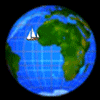Richard Konkolski - Knihy Konkolski s.r.o.
|
| DOMŮ |
|
|
FILMY-DVD | TELEVIZE | ROZHLAS | ČLÁNKY | SEDM MOŘÍ | SÓLO SAILING |
|
|
|
|
||
The 17th Century DiscoveryDuring the seventeenth century the most remarkable maritime discoveries were made by the Spaniards, Dutch, and English. In the year 1605 Quiros sailed from Callao, discovered the island of Sagittaria, since so popular under the name of Otaheite (Tahiti), and the archipelago of Espiritu Santo, or the New Hebrides of Cook. On this journey he was accompanied by Torres, the bold seaman who some years after gave his name to the strait which separates New Guinea from Australia. While the declining sun of Spain was then gilding with its last rays, the northern shore of New Holland, the meridian, splendor of the Batavian republic cast forth bright beams of light over the wide Pacific. Schouten, Le Maire and Abel Tasman While the Dutch navigators were thus dissipating the darkness of Australia, Hudson and Baffin were imortalising their names in the Arctic Ocean. Hudson Three years after we find Hudson once more attempting to discover the northwest passage in a vessel of fifty-five tons, provisioned for six months. The crew which he commanded was unfortunately utterly unworthy of such a leader, and quailed as soon as they had to encounter the fog and ice-fields of the Frozen Ocean. But, in spite of the murmurs, the dauntless commander pressed on through the strait which bears his name, until at last his little bark emerged into a boundless deep blue sea. Hudson's Bay lay before him, but the delighted discoverer was happy in the belief that the grand object of his voyage was attained, and the shortest road to India laid open to the mariners of England. It was about the beginning of August, and the spiritless crew considering the passage accomplished, urged an immediate return; but Hudson was determined on completing the adventure, and wintering if possible on the sunny shores of India. Three months long he continued tracking the coasts of that vast northern Mediterranean, now for the first time explored by civilized man, vainly hoping to see a new channel opening to the west, until at length November came and imprisoned his small vessel in compact imprisonment. A long and dreary winter awaited the ice-bound seamen, with almost exhausted provisions, and unfortunately without that heroic patience and serene concord which had sustained the sufferings of Barentz and his companions. It must indeed have been a melancholy winter for poor Hudson, solitary and friendless among scowling ruffians, hating him as the cause of their bitter misery. Spring came at last. The ship is again afloat, and on the 2lst of June,1611, the captain comes forth from his cabin. But as he steps on deck his arms are pinioned, and he finds himself in the power of a mutinous crew. All fails to move their stubborn resolution, and Hudson resigns himself bravely to his fate. A small open boat is waiting, and into this he is lowered, some powder and shot and the carpenter's box came next, followed by the carpenter himself, a strong brave fellow, the captain's one devoted adherent among the rebellious crew; the sick and infirm complete the unfortunate cargo. A signal is given, the boat is cast adrift, and soon the last faint cry for mercy expires in the breeze which carries the vessel onwards on its homeward course. Thus perished the high-minded Hudson, without further tiding or trace. Some leaders of that dark conspiracy fell in a fight with the Eskimos, and others died on the homeward voyage, which was performed under the extremity of famine. Baffin From the times of Tasman, whose bold voyage through the wastes of the Southern Pacific has already been mentioned, to those of Cook very little was done for the progress of geography. The voyages most worthy of remark during this period were those of the Cossack Semen Deshnew (1654), who sailed from the mouth of the Kolyma River round the eastern promontory of Asia, and must be considered as the discoverer of Behring's Straits, of the adventurous Dampier (1689-1691), that strange combination of the buccaneer, the author, and the naturalist, who first discovered the strait which separates New Guinea from New Ireland, of the Dutchman Roggewein (1721 -23), who made known some islands in the Pacific, of the brothers Laptew and of Prontschitschew (1734-1743), who unveiled the greatest part of the Siberian coast; of Commodore Anson (1740-1744), whose heroic sufferings and successes in the Pacific still live in the memory of his countrymen, and of the unfortunate Behring (1730-1741), who terminated his second unsuccessful exploring expedition by a miserable death on a desert island. Back to Maritime Discovery |
||||||||||||||||||||||||
|
||||||||||||||||||||||||


